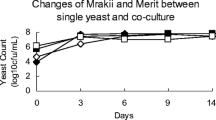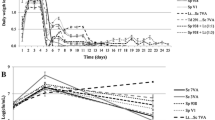Abstract
In Brazil, the use of cashew apple (Anacardium occidentale L.) to obtain new products by biotechnological process represents an important alternative to avoid wastage of a large quantity of this fruit, which reaches about 85% of the annual production of 1 million tons. This work focuses on the development of an alcoholic product obtained by the fermentation of cashew apple juice. The inoculation with two different strains of yeast Saccharomyces cerevisiae viz. SCP and SCT, were standardized to a concentration of 107 cells ml−1. Each inoculum was added to 1,500 ml of cashew must. Fermentation was performed at 28 ± 3°C and aliquots were withdrawn every 24 h to monitor soluble sugar concentrations, pH, and dry matter contents. The volatile compounds in fermented products were analyzed using the gas chromatography/mass spectrometry (GC/MS) system. After 6 days, the fermentation process was completed, cells removed by filtration and centrifugation, and the products were stabilized under refrigeration for a period of 20 days. The stabilized products were stored in glass bottles and pasteurized at 60 ± 5°C/30 min. Both fermented products contained ethanol concentration above 6% (v v−1) while methanol was not detected and total acidity was below 90 mEq l−1, representing a pH of 3.8–3.9. The volatile compounds were characterized by the presence of aldehyde (butyl aldehyde diethyl acetal, 2,4-dimethyl-hepta-2,4-dienal, and 2-methyl-2-pentenal) and ester (ethyl α-methylbutyrate) representing fruity aroma. The strain SCT was found to be better and efficient and this produced 10% more alcohol over that of strain SCP.



Similar content being viewed by others
References
Adams RP (1995) Identification of essential oils by ion trap mass spectroscopy. Academic Press, San Diego, USA
Assis A van R, Bizzo HR, Matta VM, Cabral LMC (2007) Recovery of aroma compounds of cashew apple fruit (Anacardium occidentale L) by pervaporation. Ciência e Tecnologia de Alimentos Campinas 27(2):349–354. doi:10.1590/S0101-20612007000200024
Amerine MA, Roessler EB (1983) Wines—their sensory evaluation. W.H. Freeman, New York
Berger RG (1995) Aroma biotechnology. Springer, Berlin Heidelberg, New York
Bogusz Junior S, Ketzer DCM, Gubert R, Andrades L, Gobo AB (2006) Composição química da cachaça produzida na região noroeste do Rio Grande do Sul, Brasil. Ciência e Tecnologia de Alimentos 26(4):793–798. doi:10.1590/S0101-20612006000400013
Bonino M, Scchellino R, Rizzi C, Algotti R, Delfini C, Baiocchi C (2003) Aroma compounds of an Italian wine (Ruche) by HS–SPME analysis coupled with GC–ITMS. Food Chem 80:125–133. doi:10.1016/s0308-8146(02)003-40
IBRAVIN—Instituto Brasileiro do Vinho (2010) Portaria n. 229 de 25 de outubro de 1998 do Ministério da Agricultura. Available from: http://www.ibravin.org.br/documentos.php?secao=53
Delaquis P, Cliff M, King M, Girard B, Hall J, Reynolds A (2000) Effect of two commercial malolactic cultures on the chemical and sensory properties of chancellor wines vinified with different yeasts and fermentation temperatures. Am J Viticult 51(1):42–48
Dias ALM (2010) Processo Agroindustrial: Elaboração de Fermentado de Caju—EMBRAPA. Available from: www.cnpat.embrapa.br/cnpat/cd/jss/acervo/Ct_82.pdf
Etiévant PX (1991) Wine. In: Maarse H (ed) Volatile compounds in food and beverage. Marcel Dekker Inc., New York
Franco MRB, Janzanti NS (2005) Aroma of minor tropical fruits. Flavour Fragr J 20(4):358–371. doi:10.1002/ffj.1515
Garruti DS, Franco MRB, Da Silva MAAP, Jazantti NS, Alves GL (2003) Evaluation of volatile flavour compounds from cashew apple (Anacardium occidentale L.) juice by the Osme gas chromatography/olfactometry technique. J Sci Food Agric 83:1455–1462. doi:10.1002/fsfa.1560
Garruti DS, Franco MRB, Da Silva MAAP, Jazantti NS, Alves GL (2006) Assessment of aroma impact compounds in a cashew apple-based alcoholic beverage by GC-MS and GC-olfactometry. Food Sci Technol 39(4):372–377. doi:10.1016/j.lwt.2005.02.006
Gil J, Mateo JJ, Jimenez M (1996) Aroma compounds in wine as influenced by apiculate yeasts. J Food Sci 61(6):1247–1249. doi:10.1111/j.1365-2621.1996.tb10971.x
Hang YD, Lee CY, Woodams EE (1981) Production of alcohol from apple pomace. Appl Environ Microbiol 42(6):1128–1132
Instituto Adolfo Lutz (2005) Métodos Físico-Químicos para Análise de Alimentos, 4th edn. São Paulo, Brazil
Jackson RS (1993) Wine science—principles and applications. Academic Press, San Diego
Lopez EF, Darrieto P, Gomez EF, Dubourdicu D (1995) Wine aromatic compounds by GC-MS-Sniffing. Alimentaria 264:81–84
Maciel MI, Hansen TJ, Aldinger SB, Labows JN (1986) Flavor chemistry of cashew apple juice. J Agric Food Chem 34(5):923–927. doi:10.1006/jjca.2000.0894
Maia AB (1994) Componentes secundários da aguardente. STAB 12(6):29–34
Maia JGM, Andrade EHA, Zoghbib MGB (2000) Volatile constituents of the leaves, fruits and flowers of cashew (Anacardium occidentale L.). J Food Composit Anal 13(3):227–232. doi:10.1006/jfca.2000.0894
Mamede MEO, Pastore GM (2006) Study of methods for the extraction of volatile compounds from fermented grape must. Food Chem 96(94):586–590. doi:10.1016/j.foodchem.2005.03.013
Mateo JJ, Jimenez M, Huerta T, Pastor A (1992) Comparison of volatile produced by four Saccharomyces cerevisiae strains isolated from Monastrell musts. Am J Enol Vitie 43:206
Mateo JJ, Jimenez M (2000) Monoterpenes in grape juice and wines. J Chromatogr A 881:557–567. doi:10.1016/S0021-9673(99)01342-4
Mathesis G (1992) The biogenesis of the wine flavor. Dragogo Flavor Inform Serv Rep 37:72–89
Nikanen L (1983) Aroma of beer, wine and distilled alcoholic beverages. Akademic-Verlag, Berlin, p 405
Oliveira MEB, Oliveira GSF, Maia GA, Moreira RAE, Monteiro ACO (2002) Aminoácidos livres majoritários no suco de caju: variação ao longo da safra. Rev Bras Frutic 24(1):133–137. doi:10.1590/S0100-29452002000100029
Pinal L, Cedeno M, Gutterrez H (1997) Influencing higher alcohol production in the tequila process. Biotechnol Lett 19(1):45–57
Rapp A, Knipser W (1979) 3,7-Dimethyl-okta-1, 5-dien-3, 7-diol Eine neue terpenoide Verbindung des Trauben-und Wein aromas. Vitis 18:229–233
Rodriguez-Amaya AB (2004) In: Franco MRB (eds) Aroma e sabor de alimentos—Temas atuais. Varella, São Paulo, pp 177–194
Shimazu Y, Watanabe M (1981) Quality of wine made from cAMP-added botrytized must. J Ferment Technol 59(1):27–32
Silva TG (1999) Diagnóstico vinícola do sul de Minas Gerais—I Caracterização físico-química dos vinhos. Ciência Agrotécnica 23(3):632–637
Silva FLH, Rodrigues MI, Maugeri F (1999) Dynamic modelling, simulation and optimization of an extractive continuous alcoholic fermentation process. J Chem Technol Biotechnol 74(2):176–182
Torres Neto AB, Silva ME, Silva WB, Swarnakar R, Silva FLH (2006) Cinética e caracterização físico-química do fermentado do pseudofruto do caju (Anacardium occidentale L.). Quim Nova 29(3):489–492. doi:10.1590/S0100-40422006000300015
Tromp A (1984) The effect of yeast strain, grape solids, nitrogen and temperature on fermentation rate and wine quality. S Afr J Enol Viticul 5(1):1–6
Tsukatani T, Miwa T, Furukawa M, Costanzo RC (2003) Detection thresholds for phenyl ethyl alcohol using serial dilutions in different solvents. Chem Senses 28:25–32. doi:10.1093/chemse/28.1.25
Acknowledgments
We appreciate the financial support given by CNPq (National Council for the Development of Science and Technology, Brazil) and to CAPES for fellowship offered to the author, Suzane M. Araújo.
Author information
Authors and Affiliations
Corresponding author
Additional information
This article is based on a presentation at the 32nd Symposium on Biotechnology for Fuels and Chemicals.
Rights and permissions
About this article
Cite this article
Araújo, S.M., Silva, C.F., Moreira, J.J.S. et al. Biotechnological process for obtaining new fermented products from cashew apple fruit by Saccharomyces cerevisiae strains. J Ind Microbiol Biotechnol 38, 1161–1169 (2011). https://doi.org/10.1007/s10295-010-0891-6
Received:
Accepted:
Published:
Issue Date:
DOI: https://doi.org/10.1007/s10295-010-0891-6




